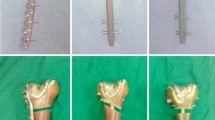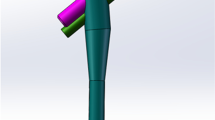Abstract
Background: The incidence of fractures in the trochanteric area has risen with the increasing numbers of elderly people with osteoporosis. Although dynamic hip screw fixation is the gold standard for the treatment of stable intertrochanteric femur fractures, treatment of unstable intertrochanteric femur fractures still remains controversial. Intramedullary devices such as Gamma nail or proximal femoral nail and proximal anatomic femur plates are in use for the treatment of intertrochanteric femur fractures. There are still many investigations to find the optimal implant to treat these fractures with minimum complications. For this reason, we aimed to perform a biomechanical comparison of the proximal femoral nail and the locking proximal anatomic femoral plate in the treatment of unstable intertrochanteric fractures.
Materials and Methods: Twenty synthetic, third generation human femur models, obtained for this purpose, were divided into two groups of 10 bones each. Femurs were provided as a standard representation of AO/Orthopedic Trauma Associationtype 31-A2 unstable fractures. Two types of implantations were inserted: the proximal femoral intramedullary nail in the first group and the locking anatomic femoral plate in the second group. Axial load was applied to the fracture models through the femoral head using a material testing machine, and the biomechanical properties of the implant types were compared.
Result: Nail and plate models were locked distally at the same level. Axial steady load with a 5 mm/m velocity was applied through the mechanical axis of femur bone models. Axial loading in the proximal femoral intramedullary nail group was 1.78-fold greater compared to the plate group. All bones that had the plate applied were fractured in the portion containing the distal locking screw.
Conclusion: The proximal femoral intramedullary nail provides more stability and allows for earlier weight bearing than the locking plate when used for the treatment of unstable intertrochanteric fractures of the femur. Clinicians should be cautious for early weight bearing with locking plate for unstable intertrochanteric femur fractures.
Similar content being viewed by others
References
Weller I, Wai K, Jaglal S, Kreder HJ. The effect of hospital type and surgical delay on mortality after surgery for hip fracture. J Bone Joint Surg Br 2005;87:361–6.
Kregor J, Obremskey T, Kreder J, Swiontkowski F, Evidence-Based Orthopaedic Trauma Working Group. Unstable pertrochanteric femoral fractures. J Orthop Trauma 2005;19:63–6.
Min K, Kim Y, Kim K, Lee B, Cho R, Ha C, et al. Proximal femoral nail for the treatment of reverse obliquity intertrochanteric fractures compared with gamma nail. J Trauma 2007;63:1054–60.
Parker J, Handoll HH. Intramedullary nails for extracapsular hip fractures in adults. Cochrane Database Syst Rev 2006;19(3):CD004961.
Rosenblum F, Zuckerman D, Kummer J, Tam BS. A biomechanical evaluation of the Gamma nail. J Bone Joint Surg Br 1992;74:352–7.
Werner-Tutschku W, Lajtai G, Schmiedhuber G, Lang T, Pirkl C, Orthner E. Intra-and perioperative complications in the stabilization of per-and subtrochanteric femoral fractures by means of PFN. Unfallchirurg 2002;105:881–5.
Streubel N, Moustoukas J, Obremskey WT. Mechanical failure after locking plate fixation of unstable intertrochanteric femur fractures. J Orthop Trauma 2013;27:22–8.
Crist D, Khalafi A, Hazelwood J, Lee MA. A biomechanical comparison of locked plate fixation with percutaneous insertion capability versus the angled blade plate in a subtrochanteric fracture gap model. J Orthop Trauma 2009;23:622–7.
Floyd C, O’Toole V, Stall A, Forward P, Nabili M, Shillingburg D, et al. Biomechanical comparison of proximal locking plates and blade plates for the treatment of comminuted subtrochanteric femoral fractures. J Orthop Trauma 2009;23:628–33.
Kim W, Oh W, Byun S, Oh K, Kim J, Min K, et al. A biomechanical analysis of locking plate fixation with minimally invasive plate osteosynthesis in a subtrochanteric fracture model. J Trauma 2011;70:E19–23.
Levy N, Capozzi D, Mont MA. Intertrochanteric hip fractures. In: Browner B, Jupiter B, Levine M, editors. Skeletal Trauma. Vol. 2. USA: WB Saunders Company; 1992. p. 1443–71.
Boldin C, Seibert J, Fankhauser F, Peicha G, Grechenig W, Szyszkowitz R. The proximal femoral nail (PFN)–A minimal invasive treatment of unstable proximal femoral fractures: A prospective study of 55 patients with a followup of 15 months. Acta Orthop Scand 2003;74:53–8.
Hasenboehler A, Agudelo F, Morgan J, Smith R, Hak J, Stahel PF. Treatment of complex proximal femoral fractures with the proximal femur locking compression plate. Orthopedics 2007;30:618–23.
Forward P, Doro J, O’Toole V, Kim H, Floyd C, Sciadini F, et al. A biomechanical comparison of a lockinge, plate, a nail, and a 95° angled blade plate for fixation of subtrochanteric femoral fractures. J Orthop Trauma 2012;26:334–40.
Ballal S, Emms N, Thomas G. Proximal femoral nail failures in extracapsular fractures of the hip. J Orthop Surg (Hong Kong) 2008;16:146–9.
Akan K, Cift H, Ozkan K, Eceviz E, Tasyikan L, Eren A. Effect of osteoporosis on clinical outcomes in intertrochanteric hip fractures treated with a proximal femoral nail. J Int Med Res 2011;39:857–65.
Malkani L, Karandikar N. Revision fixation for failed intertrochanteric fractures. Tech Orthop 2002;17:443–7.
Parker J, Handoll HH. Gamma and other cephalocondylic intramedullary nails versus extramedullary implants for extracapsular hip fractures in adults. Cochrane Database Syst Rev 2008;16(3):CD000093.
Jacobs R, McClain O, Armstrong HJ. Internal fixation of intertrochanteric hip fractures: A clinical and biomechanical study. Clin Orthop Relat Res 1980;146:62–70.
Author information
Authors and Affiliations
Corresponding author
Rights and permissions
About this article
Cite this article
Ozkan, K., Türkmen, İ., Sahin, A. et al. A biomechanical comparison of proximal femoral nails and locking proximal anatomic femoral plates in femoral fracture fixation. IJOO 49, 347–351 (2015). https://doi.org/10.4103/0019-5413.156220
Published:
Issue Date:
DOI: https://doi.org/10.4103/0019-5413.156220
Key words
- Biomechanical comparison
- intertrochanteric femur fractures
- intramedullary nail
- proximal anatomic femoral plate




